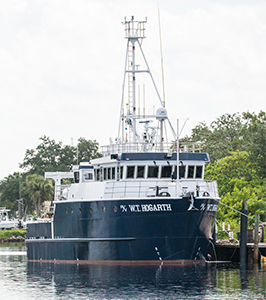When it came time to replace its aging workhorse R/V Bellows, the Florida Institute of Oceanography (FIO) planned to do what it has always done: Buy and retrofit a used boat.
Those plans changed when a state official encouraged the institute to build a new vessel that truly met its needs. FIO, a coalition of Florida colleges and universities, state agencies and nonprofit groups, followed that advice.
The result is W.T. Hogarth, a 78-foot steel monohull powered by Caterpillar engines, outfitted with a dynamic positioning system and packed with sensitive scientific equipment. Boksa Marine Design provided the vessel plans and Duckworth Steel Boats built the vessel, which is named for the institute’s former director who oversaw the boat’s development and led fundraising.
“We tried to make sure we had all the instrumentation for doing research, but at the same time the instrumentation it needed for teaching,” Bill Hogarth, who stepped down as FIO director in August 2016, said in a recent interview. “It is used quite a bit for teaching and a lot of classwork. That was the design purpose — to make sure we had what the faculty wanted, and I think we accomplished that.”
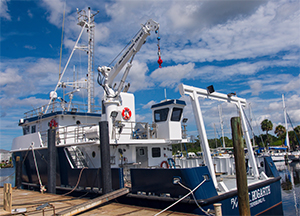 |
|
The new vessel underwent final outfitting in mid-September at Duckworth Steel Boats before sea trials. “That vessel has a lot in there and they are going to be very happy with it,” said Nick Boksa of Boksa Marine Design. |
|
Jonathan Dyer Photography |
W.T. Hogarth will replace the 48-year-old Bellows, which has taken more than 6,000 students to sea and advanced countless research projects during its four decades as a research vessel. Upon its scheduled delivery in late September, the newbuild will join the 115-foot Weatherbird II and a handful of smaller institute boats.
FIO officials started thinking about replacing Bellows a decade ago, said Philip Kramer, the organization’s current director. The state of Florida paid $3 million toward the estimated $6 million boat, and coalition partners contributed a share based on their usage. The city of St. Petersburg — the boat’s home port — also donated $250,000 toward the vessel.
Given those funding constraints, FIO wanted a vessel that could be built and outfitted as efficiently as possible, Kramer said. The new boat also had to cost about the same to operate as Bellows, about $5,600 a day, and be available for year-round use.
Meeting those goals meant building a monohull instead of a catamaran. Cost was one factor, but Florida’s unforgiving offshore waters were another knock on the stiffer catamaran hull. Catamarans also have limited hull space for berthing, equipment and storage.
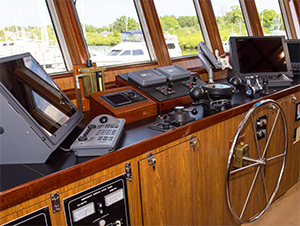 |
|
W.T. Hogarth’s comfortable and well-appointed wheelhouse is outfitted with Furuno and Simrad navigation electronics. In addition to the house, the upper deck has accommodations for the captain and mate. |
|
Jonathan Dyer Photography |
Naval architect Nick Boksa, president of Boksa Marine Design of Lithia, Fla., was charged with replicating Bellows’ strengths in a larger, more efficient envelope. He also found space for separate wet and dry labs, a galley and mess, and a standalone wheelhouse — three features Bellows lacks.
“They weren’t really trying to redefine the wheel,” he said. “The goal was to make a more efficient and more up-to-date vessel that doesn’t cost too much to run and can do all these things the scientists want it to do.”
W.T. Hogarth has a tri-deck layout to maximize space. The upper deck houses the spacious wheelhouse, along with a cabin for the captain and mate and a full head with a shower. Aft of the wheelhouse is a stern-facing “doghouse” with vessel and A-frame controls. The boat also has a bulbous bow for efficiency in the water.
Down one level to the main deck, W.T. Hogarth has wet and dry labs, a galley and mess, a head and a computer lab. The lower level has four staterooms — two quads and two doubles — forward of the engine room. Vibration-damping insulation and isolation mounts reduce engine noise for those compartments.
“Every time we walk on board, we think, ‘This is a little ship,’” Boksa said. “There is just a lot on a 78-foot platform. That vessel has a lot in there and they are going to be very happy with it.”
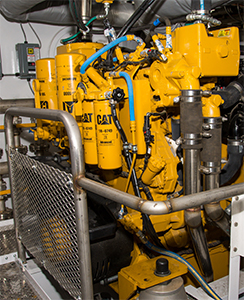 |
|
Propulsion aboard W.T. Hogarth is provided by twin Caterpillar C18 diesels each producing 600 hp. The main engines are complemented by a 100-hp Thrustmaster bow thruster for maneuverability. |
|
Jonathan Dyer Photography |
FIO coalition members perform a wide range of scientific endeavors off Florida, from taking water samples to mapping the seafloor to conducting fisheries research. Weatherbird II, for instance, spends long stretches in the Gulf of Mexico studying effects from the 2010 Deepwater Horizon oil spill.
Given its key role as a floating lab, W.T. Hogarth has advanced scientific equipment on board, including a remotely operated vehicle, Simrad EK80 echosounder and advanced multibeam sonar capable of mapping the seafloor up to 2,600 feet below the surface. A Sea-Bird conductivity, temperature and depth (CTD) unit gives researchers tools to understand the water column.
“Breakthroughs in marine science are often related to advances in technology,” Kramer said, referring to the latest equipment installed aboard W.T. Hogarth.
“Florida has the second-largest coastline behind California, but very little of the state waters out to the shelf have been mapped in a fairly standard resolution,” he said. “We are anticipating having this vessel brought in to help fill mapping gaps.”
The new boat’s propulsion system consists of twin 600-hp Caterpillar C18 Tier 3 engines turning 41-inch nibral props through ZF Marine reduction gears. Twin 55-kW John Deere gensets provide electrical power and a third 55-kW unit provides emergency power. The vessel has a 100-hp Thrustmaster bow thruster and Kongsberg dynamic positioning system that can hold position in 5-foot seas and 20-knot winds.
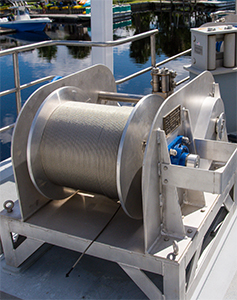 |
|
The new research vessel is outfitted with an aft winch that can hold up to 1,500 feet of 1/3-inch wire. It also has smaller winches for its scientific systems. |
|
Jonathan Dyer Photography |
The modern wheelhouse electronics suite consists of a Furuno radar and depth sounder, Nobeltec navigation software, Simrad AP80 autopilot and gyrocompass. Communications gear includes VHF radios and a KVH mini-broadband satellite system.
W.T. Hogarth is the first research vessel built at Duckworth Steel Boats of Tarpon Springs, Fla. Despite a lack of experience with boats in this sector, Duckworth had the vessel on schedule and on budget.
“I must say the shipyard has gone above and beyond what we were anticipating,” Kramer said. “They have taken a tremendous amount of pride in their work and it has been a pleasure to work with them.”
W.T. Hogarth was scheduled to begin sea trials in September. After delivery, FIO planned vessel visits to several Florida cities to promote the research boat with its partner organizations.
Come spring 2018, W.T. Hogarth will go to work training the next generation of scientists looking to promote and protect Florida’s $400 billion coastal economy.

